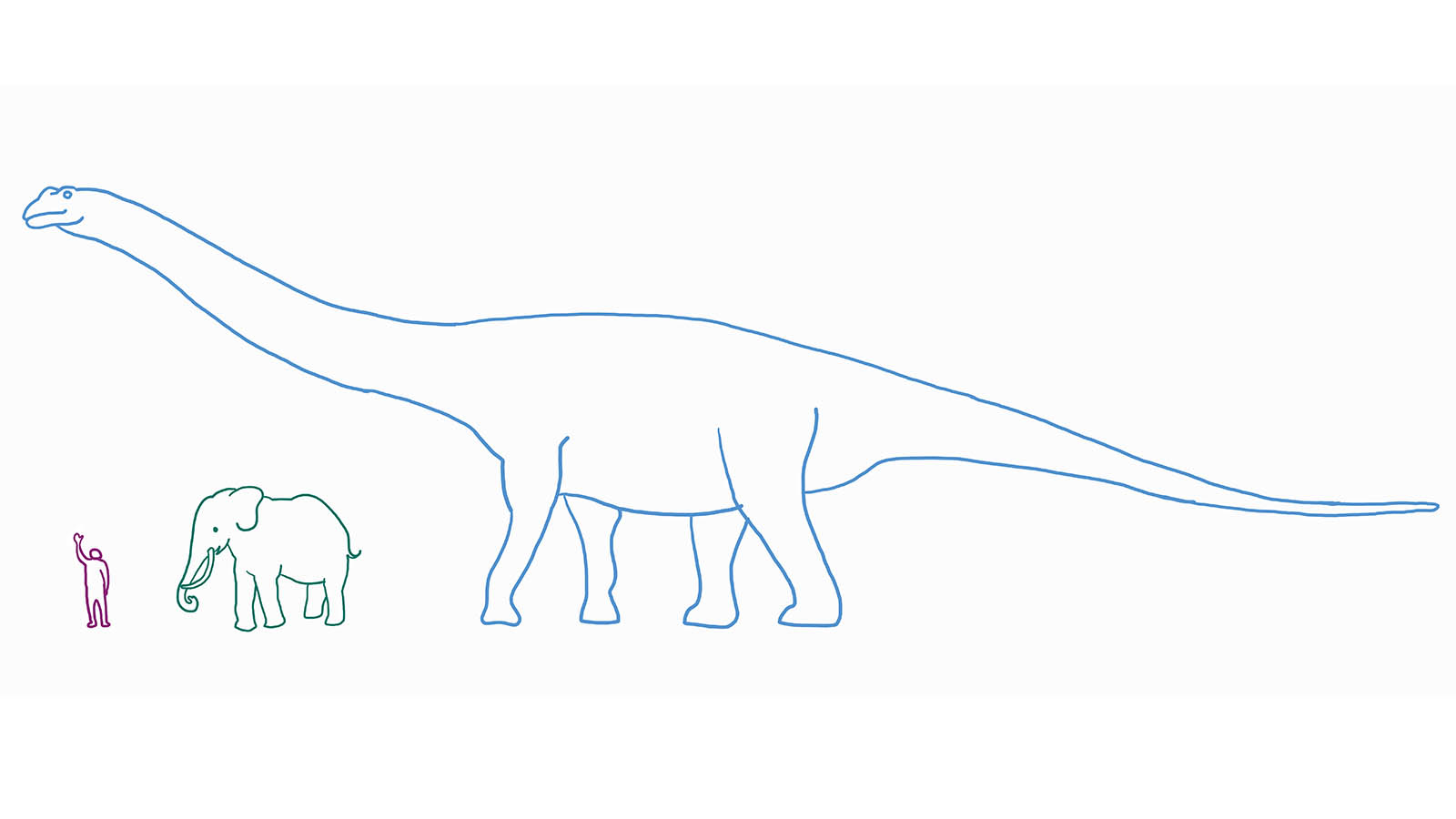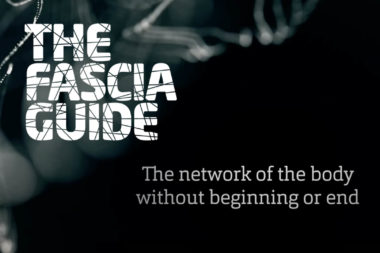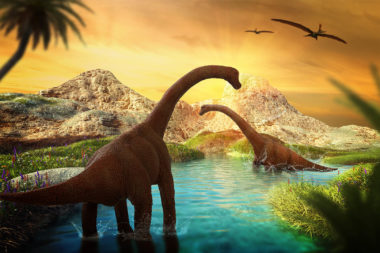

Biotensegrity: How did the dinosaurs handle the pressure of gravity?
In the seventies, orthopedic surgeon Dr. Stephen Levin was visiting the Natural History Museum, watching the dinosaurs.
When looking at the Brachiosaurus he saw a lot of wires holding up the long neck.
Then he suddenly realized that this biological structure is impossible according to the current idea of bones and muscles working in a lever system.
The traditional theory of biological structuring was flawed – and Dr. Levin was intrigued!

Levin discovered that the structural principle called Tensegrity – a combination of words Tension and Integrity – was not only applicable when building bridges – this was the structure of all living biological creatures.
The principle worked on all organisms, from single celled organisms, to quadrupeds and humans – and it actually explained how the dinosaurs could keep their neck up.
Dr Levin coined the term Biotensegrity and this profoundly changed the way we look at how the body is structured, and what keeps it together.

The picture shows The Needle Tower – a fascinating piece of work that is held together and held up because of the tension and equilibrium, tensegrity, created between the different parts.
Biotensegrity – how does it work?
In a biotensegrity system, compression members flow without touching each other in a sea of balanced tension members. When deformed by an outside force the strain is distributed over the whole area – and not only the local place being deformed.
In simple terms, it is a system where hard parts, like bones, and soft parts, like threads of collagen (connective tissue) work together to adsorb, distribute and release force and tension.
The skeleton is not, as previously thought, the hanger on which everything depends, for instance. The skeleton is the numb brace that keeps apart from the fascia layers and stabilizes the connective tissue structures, like Needle Tower in the picture above.
But the body is not as static as the tower in the picture. This is because the body wires, the Fascia, are not two, five or ten in number, but many many more. Some stretched, and some are lax, and they tense and relax at every movement.
You could describe it as the skeleton floating freely in the Fascia however, if the soft tissue is crooked, as a result the skeleton will be bent. If we work to restore and maintain delicate parts, muscles, and connective tissue, we help skeleton float freely inside complex structures.
- By Axel Bohlin Founder & Editor, The Fascia Guide

Hyaluronic acid and densification
Fascian skapar ett tredimensionellt nätverk i kroppen, av omväxlande lös och tät bindväv, som möjliggör att alla celler och organsystem i kroppen kan samarbeta som en integrerad helhet.
Fascia helps us understand the body as a whole
Look at a ballet dancer, a gymnast or a drummer and study their movement, feeling, timing, it is easy to be fascinated by how fast it is. Fascia helps us understand how the body is able to function in such an incredible way.
Is the body smarter than a supercomputer?
All living beings require water, that’s something we all know.
Water is so common and obvious to us that it has become uninteresting, almost too simple to study. We think we know everything about water, how it behaves under different circumstances.
It freezes into ice, a solid form, when the temperature drops below zero, and it boils and evaporates at 100° C, in the temperature range in between it flows and splashes as we know water to do. Our bodies contain between 60-80% water, depending on age, gender, and body fat.
But do we really know everything about water? No, according to many researchers, we do not.
Fascia as a flow – a new way of explaining the body’s function
By beginning to see the body as something that is alive, and not something that is dead, we have been able to begin to notice other things.
Frequently Asked Questions about Fascia
On the Fascia Guide FAQ we have gathered the most common questions and answers about Fascia. Is there anything you would like to know? Visit the page and submit your question.
Fascia and The Living Body
“Fascia and the Living Body” is a document about the scientific understanding of the body as a living whole.
The strength of collagen
In order for a tendon or ligament to become strong, a lot of collagen fibers are required, as well as sufficient cross-links to stabilize the fibers so that they do not “slide” against each other.
9 tips: How to keep your Fascia healthy and balanced
One of the best ways to keep yourself healthy, free from pain and injuries is to take care of your Fascia. Here are 9 tips on how to take care of your Fascia.
Inflammation in Fascia causes pain – new discoveries presented in Stockholm
Dr Heike Jäger, Professor Karl Arfors and innovator Hans Bohlin presented the latest research regarding Fascia, inflammation and Fascia treatment in Stockholm, May 2017.
The building blocks, collagen as a supplement
Collagen is the most common protein in our body and makes up most of our body’s structures such as fascia, bone tissue, cartilage, blood vessels, lymph vessels, eyes, skin, nails, and more.
The discovery of a new cell at the 2018 Fascia Research Congress in Berlin
Fascia research has sparked a wildfire of new insights that are challenging conventional belief about how the body works – and the latest insights are presented at the 2018 Fascia Research Congress in Berlin.
Understanding Fascia in 10 minutes – the must see German documentary
In early 2013, a German documentary was broadcast based on the latest research on the Fascia. It provides a very basic introduction for newcomers. To help you get a quick overview of Fascia, we have cut together a 10 minute version.
Fascia Anatomy & Physiology
The old way of explaining Fascia, as a thin layer around the muscles, is obsolete. It is ONE system & this insight completely changes how we look at the body.
Fascia – The Body’s Network Without Beginning or End
Fascia – The Body’s Network Without Beginning or End
Problems linked to Fascia
Fascia is a system of flexible connective tissue encapsulating everything in the body. If the system is running smoothly, all is fine, but when some parts become stiff, tense or inflamed, there will be consequences.
Fascia Research Database
Fascia research has sparked an ongoing global revolution in the anatomical research field. In The Fascia Guide Research Database we have gathered hundreds of research articles about fascia.
How do you know how to place your feet – what is proprioception?
Proprioception is often described as the innate ability to sense the body’s position in relation to the environment and space, also known as spatial awareness. It’s a vital skill for all humans and animals, but it can vary in quality and it can be improved
Fascia loads and unloads pressure
What do we know about the Fascias function and what affects the Fascias ability to rebuild – and how can we use that knowledge in our everyday lives?
The hormone cortisol
Long-term stress and strain on the body, due to factors such as excessive worrying, lack of sleep, and overworking for extended periods of time, can impair your immune system.
Are my problems related to Fascia?
Most of the questions we receive are about various issues and discomforts related to Fascia. How can Fascia represent a new way to treat and prevent problems?
The mysterious world under the skin – German Fascia Documentary from 2018
Get a deeper introduction to new Fascia Research with the 2018 German documentary “The mysterious world under the skin”.
What is Fascia? Connective tissue in a system with no beginning & no end
What is Fascia? New research shows that it is more than the layer around the muscles. It is a network without beginning or end, from the skin, through the entire body, to the smallest cell.
We have been preparing our whole lives to NOT be able to understand the importance of fascia
To truly understand Fascia, you must understand the whole. But how do you do that if you have trained all your life to divide and separate?
7 things you should now about Vitamin C
Vitamin C is good for the immune system, but did you know that it also supports tissue regeneration or that we use up 7 times more Vitamin C during stress?
New Fascia Research has taken us back to an observing stage
The new discoveries and knowledge about Fascia has taken us back to an observing stage – we have to investigate our surroundings to get an understanding for what to measure.
Why Fascia is still relatively unknown
Here are three major reasons why the Fascia’s central importance to the body’s functionality is not nousehold knowledge. It might be helpful to bare these in mind when relating to current and previous research.
Welcome to The Fascia Guide
This is how you get started with The Fascia Guide
Fascia Expert: “An explosion of new research in the last 10 years”
In 2015 veterinary Vibeke S Elbrønd published the first report on Fascia and horses. To make that happen she had to learn all there was regarding fascia, she had to become a fascia expert.
What is fascia and in what way does fascia change the whole way of looking at the body?
Fascia is a network of connective tissue, without beginning and end, which encloses everything in the whole body, from muscles and bones, to organs and cells. But what does that mean?
Strolling under the skin: How does it look inside a living body?
Strolling under the skin is a fascinating journey inside a living body. With small camcorders, Dr. Jean Claeude Guimberteau has managed to capture how Fasica actually looks in a living human body.
How do we learn to understand Fascia?
Fascia is a new perspective, a completely new way of looking at the body, a new way of conducting research and a new way of understanding the world. So how do you learn to understand Fascia?
Fascia: New research changes the way we look at pain
From Newton, to Einstein, to the new wildfire of Fascia Research. How do we understand things from a different perspective?
The Fascia Movie – The Body’s Network Without Beginning or End
“Fascia – The Body’s Network Without Beginning or End” is a documentary about how new research profoundly changes the way we look at the living human body.
Biotensegrity: How did the dinosaurs handle the pressure of gravity?
In the 70s when the orthopedic surgeon Dr. Stephen Levin was at a natural history museum and saw the wires holding up the neck of a dinosaur, he did not get the picture to go together. How could his neck have been held up originally?
The building blocks, collagen as a supplement
Kollagen är kroppens vanligaste protein och bygger upp det mesta i vår kropp, Fascia, benvävnad, brosk, blodkärl, lymfkärl, ögon, hud, naglar, mm, mm.
Dr. Stephen Levin at the Fascia Research Congress, Washington DC 2015
Click the subtitle icon for a subtitled version
In depth: Longer lecture on Biotensegrity
Tom Myers: What is tensegrity?
Tom Myers continues talking about Biotensegrity – a new way of thinking than what we are used to.
A strong and flexible structure
A demonstration of Tensegrity. See how the “ball” bounces and what happens when ONE thread is cut off.
A tensegrity leg
The film shows a biomechanical representation of how leg and foot load and relieve pressure and tension.
How do we learn to understand Fascia?
Fascia is a new perspective, a completely new way of looking at the body, a new way of conducting research and a new way of understanding the world. So how do you learn to understand Fascia?
The immune system: How it works & how to boost it
You probably know that the immune system is our defensive wall protecting us from the threats from the outside world – but do you know how it works and how to boost it?
Fascia Research Database
Fascia research has sparked an ongoing global revolution in the anatomical research field. In The Fascia Guide Research Database we have gathered hundreds of research articles about fascia.
Why do so many female football players suffer from cruciate ligament injuries?
A lot of injuries after a long break might not be that unusual – but why do so many female athletes suffer from cruciate ligament injuries?
Fascia as a flow – a new way of explaining the body’s function
By beginning to see the body as something that is alive, and not something that is dead, we have been able to begin to notice other things.
Strolling under the skin: How does it look inside a living body?
Strolling under the skin is a fascinating journey inside a living body. With small camcorders, Dr. Jean Claeude Guimberteau has managed to capture how Fasica actually looks in a living human body.
Problems linked to Fascia
Fascia is a system of flexible connective tissue encapsulating everything in the body. If the system is running smoothly, all is fine, but when some parts become stiff, tense or inflamed, there will be consequences.
Fascia loads and unloads pressure
What do we know about the Fascias function and what affects the Fascias ability to rebuild – and how can we use that knowledge in our everyday lives?
Fascia does not only envelope the whole body, it turns the way we look at the body upside down
At the 2015 Fascia Research Congress in Washington DC, Tom Myers, the author of Anatomy Trains, gives a short introduction to Fascia and how new research changes the way we look at pain and discomfort.
Fascia and The Living Body
“Fascia and the Living Body” is a document about the scientific understanding of the body as a living whole.
The discovery of a new cell at the 2018 Fascia Research Congress in Berlin
Fascia research has sparked a wildfire of new insights that are challenging conventional belief about how the body works – and the latest insights are presented at the 2018 Fascia Research Congress in Berlin.
We have been preparing our whole lives to NOT be able to understand the importance of fascia
To truly understand Fascia, you must understand the whole. But how do you do that if you have trained all your life to divide and separate?
Stretching the fascia is vital when recovering from injury
David Lesondak describes how stretching the fascia is vital for rehabilitation from injury at the 2018 Fascia Research Congress in Berlin
Biotensegrity: How did the dinosaurs handle the pressure of gravity?
In the 70s when the orthopedic surgeon Dr. Stephen Levin was at a natural history museum and saw the wires holding up the neck of a dinosaur, he did not get the picture to go together. How could his neck have been held up originally?
Fascia Lines are the intersections of the body
The concept of Fascia Lines is a great way to understand how the body functions and how treatment can be optimized to increase mobility and functionality. The main principle is that muscles, no matter what they do individually, also affect tissues throughout the entire body.
Get the lymph flow!
Keep the flow of lymph alive! What can I do to increase the lymph flow?
Fascia is the largest organ in the body
Fascia or interstitium? Two different terms for the body’s “newly discovered” largest organ.
Is cancer fascia related? New insights presented in Boston 2015
New research leads to insights and by looking at the body in a completely new way we get new perspectives and explanations to symptoms and diseases. At the 2015 Joint Conference on Acupuncture, Oncology and Fascia in Boston, research was presented regarding Fascia and Cancer
Fascia – a New Anatomical Perspective
Recent research in recent years shows that Fascia has a much greater significance for health, aches, and pain than previously believed.
Frequently Asked Questions about Fascia
On the Fascia Guide FAQ we have gathered the most common questions and answers about Fascia. Is there anything you would like to know? Visit the page and submit your question.
Can you heal osteoarthritis?
The function of the articular cartilage is to reduce friction between the two articular cartilage surfaces and facilitate sliding when the joint moves, and to absorb the load when the joint is exposed to pressure, compression
The importance of vitamin C in pregnancy, childbirth and jaundice in newborns.
Vitamin C has many different actions in the body. It is a coenzyme, which assist in various physiological processes in the body and it is a powerful antioxidant.
7 things you should now about Vitamin C
Vitamin C is good for the immune system, but did you know that it also supports tissue regeneration or that we use up 7 times more Vitamin C during stress?
Stress and sugar harms fascia functions
What we do know for sure is that the abundance of sugar has a negative effect on the fascia and makes it less elastic. Stress also affects the fascia in a disadvantageous way
What is fascia and in what way does fascia change the whole way of looking at the body?
Fascia is a network of connective tissue, without beginning and end, which encloses everything in the whole body, from muscles and bones, to organs and cells. But what does that mean?
Understanding Fascia in 10 minutes – the must see German documentary
In early 2013, a German documentary was broadcast based on the latest research on the Fascia. It provides a very basic introduction for newcomers. To help you get a quick overview of Fascia, we have cut together a 10 minute version.
Disease is excess oxidation
Diseases are an excess of oxidation – Redox physiology is an excess of oxidation greater than reduction.
The Fascia Movie – The Body’s Network Without Beginning or End
“Fascia – The Body’s Network Without Beginning or End” is a documentary about how new research profoundly changes the way we look at the living human body.
Growing interest in Fascia treatment: “Fascia problems are often under diagnosed”
David Lesondak is a structural integrator and a myofascial specialist who has been working for many years trying to explain what fascia is, as well as the benefits you get from treating different problems with fascia treatment. In an interview at the Fascia Research Congress in Berlin 2018, he describes the basics of what fascia is and what challenges it is facing in the strive for recognition in the medical field.
Inflammation in Fascia causes pain – new discoveries presented in Stockholm
Dr Heike Jäger, Professor Karl Arfors and innovator Hans Bohlin presented the latest research regarding Fascia, inflammation and Fascia treatment in Stockholm, May 2017.
What is Fascia? Connective tissue in a system with no beginning & no end
What is Fascia? New research shows that it is more than the layer around the muscles. It is a network without beginning or end, from the skin, through the entire body, to the smallest cell.
Why is resistance to vitamin C still so great?
Why do all “experts” on TV say that we don’t need or that it’s harmful to take extra vitamin C?
The Fascia Guide Method
During the last couple of years we have developed a simple but powerful method of communication, used by hundreds of health professionals, to inspire their customers & improve relations.
Fascia: New research changes the way we look at pain
From Newton, to Einstein, to the new wildfire of Fascia Research. How do we understand things from a different perspective?
Fluid flow in the fascia & how it is affected by treatment & vibrations
Recently, a German researcher showed that the connective tissue in a human transports 15 l of water in 48 hours, which is a relatively large amount compared to for example the amount of blood and the lymphatic system.
Are my problems related to Fascia?
Most of the questions we receive are about various issues and discomforts related to Fascia. How can Fascia represent a new way to treat and prevent problems?
Fascia helps us understand the body as a whole
Look at a ballet dancer, a gymnast or a drummer and study their movement, feeling, timing, it is easy to be fascinated by how fast it is. Fascia helps us understand how the body is able to function in such an incredible way.
9 tips: How to keep your Fascia healthy and balanced
One of the best ways to keep yourself healthy, free from pain and injuries is to take care of your Fascia. Here are 9 tips on how to take care of your Fascia.
To understand Fascia we need to cross the bridge & see things from another perspective
Exclusive interview with Gil Headly explaining how Fascia changes the perspective on how we look at the body at the 2015 Fascia Research Congress in Washington DC.
The mysterious world under the skin – German Fascia Documentary from 2018
Get a deeper introduction to new Fascia Research with the 2018 German documentary “The mysterious world under the skin”.
What is Biotensegrity? Interview with Dr. Stephen Levin
Exclusive interview with Dr Stephen Levin, the worlds leading expert on Biotensegrity, at the Fascia Research Congress 2015.
New Fascia Research has taken us back to an observing stage
The new discoveries and knowledge about Fascia has taken us back to an observing stage – we have to investigate our surroundings to get an understanding for what to measure.
Fascia in Horses – Danish veterinary exploring uncharted territory
In 2015 veterinary Vibeke S Elbrønd published the first report on Fascia and horses. Through autopsy she found that the horse has the same kind of chains and networks of connective tissue through the body, as found in humans.
Anatomy Trains by Tom Myers helps us understand functions of movement
Tom Myers is perhaps best known for his book Anatomy Trains, where he describes the Myofascial lines which help us understand movement and functions of the body
Training for strengthened Fascia
Exercise increases collagen production in tendons, ligaments and all Fascia. To stimulate collagen formation in tendons and ligaments, it doesn’t matter if the exercise is eccentric (muscle contraction during extension) or concentric (muscle contraction during shortening).
Is fascia affected by sex hormones?
Banbrytande ny forskning visar hur kollagenproduktionen över hela kroppen påverkas av könshormoner, som t ex östrogen. Läs mer här
Why Fascia is still relatively unknown
Here are three major reasons why the Fascia’s central importance to the body’s functionality is not nousehold knowledge. It might be helpful to bare these in mind when relating to current and previous research.
What causes back pain?
New research shows that low back pain is caused by inflammation in the Fascia. But why are we getting low back pain and what happens in our body when we get back pain?
Fascia Expert: “An explosion of new research in the last 10 years”
In 2015 veterinary Vibeke S Elbrønd published the first report on Fascia and horses. To make that happen she had to learn all there was regarding fascia, she had to become a fascia expert.
The influence of mechanical forces on Fascia?
Connective tissue / fascia is an incredibly adaptable and plastic tissue. It is transformed, remodeled and strengthened or weakened according to the mechanical stimulation (load) to which it is exposed. If we don’t move, the tissue will diminish.
Therefore, the researchers believe that the nervous system resides in Fascia
The fascial network exists in various compositions, structures, and configurations throughout the entire body and is a crucial and essential part of the body’s function…



























































